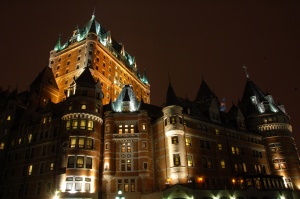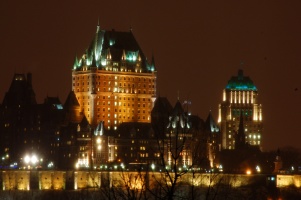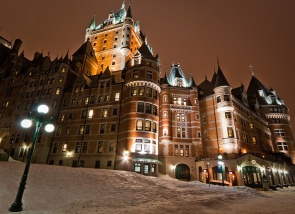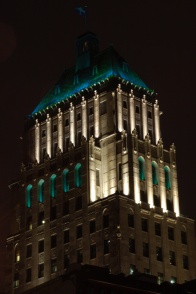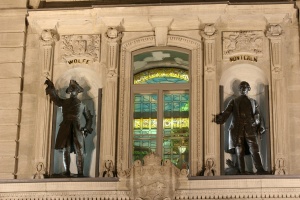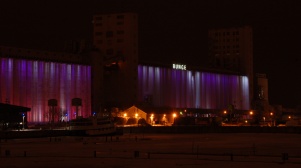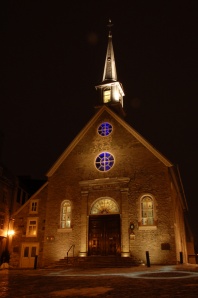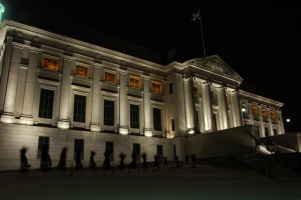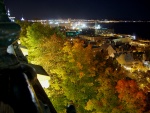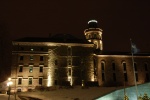
The Illumination of the De la Cité Borough in Québec City
par Demers, Amélie
When night falls, Quebec City lights up—illuminated as the result of a desire to boost the city’s nighttime appeal. More than just a lighting strategy, this initiative is also an original way to showcase heritage treasures. By drawing attention to architectural and natural features, the capital’s lighting plan encourages the public to see the city through new eyes, with a series of stunning nightscapes.
Article disponible en français : Mise en lumière de l’arrondissement de la Cité à Québec
From Functional Lighting to Heritage Aesthetics
Electricity was all the rage in late 19th–early 20th century Europe, leading to a number of ambitious illumination projects at colonial exhibitions and world fairs (NOTE 1).But it wasn’t until the Eiffel Tower was lit up in 1936 that real interest emerged in temporarily illuminating monuments. Such projects were only occasional, however, and were not part of any urban development policy.
The functionalist movement dominated urban planning throughout the 20th century, underscoring the need for cities to be efficient and practical (NOTE 2). This approach enhanced quality of life and, influenced by the needs of motorists and pedestrians, made cities safer at night. But the early 1980s saw a new form of lighting emerge, inspired by techniques used in the world of entertainment. This “qualitative” lighting put more emphasis on aesthetics and showcasing cities (NOTE 3). Lyon in France blazed a new trail with an innovative lighting plan in 1989 and developed unparalleled expertise that made the city the worldwide leader in nighttime designs. Other cities went on to adopt lighting plans of their own to promote their heritage and identity while creating attractive nighttime environments.
Quebec City’s Lighting Plan
In 1997 Commission de la capitale nationale du Québec (CCNQ) was commissioned by the government of Quebec to develop a lighting plan for Quebec City in preparation for the city’s 400th anniversary celebrations in 2008 (NOTE 4). CCNQ and its partners drew up a list of criteria for the buildings and sites to be illuminated: features and elements closely associated with the city’s identity; landmarks; heritage treasures; permanent, recognizable structures; public places; and buildings of significance to the community (NOTE 5). To date 16 lighting projects have been completed, ten of which are in the central De la Cité borough.
Thus harnessed, light has the ability to prioritize urban space. By focusing on distinctive elements, it helps us read the built environment, drawing our attention to items of special interest. Light is both an expression of recognition and a means of highlighting the city’s most representative elements by distinguishing them from their surroundings (NOTE 6). It shapes space and draws our attention to key features. Light also enables us to interpret the city’s architecture and structure by choosing what is illuminated—or in which colour—and highlights certain details that are passed over in daytime (NOTE 7).
Cape Diamond
Cape Diamond has been illuminated since December 3, 2001, lit from below with white light that accentuates the escarpment and clearly marks the division between the Petit-Champlain neighbourhood and Dufferin Terrace. All eyes are drawn to, but not overwhelmed by the mass of rock that dominates Lower Town. The illumination also recalls the promontory’s role as a natural fortress at the top of which Champlain had Fort Saint-Louis built in 1620 (NOTE 8).
Château Frontenac
Château Frontenac was first illuminated on December 31, 1999, on the initiative of the Fairmont chain (which owns the hotel), Commission de la capitale nationale du Québec, and Parks Canada (NOTE 9). The lighting design highlights the neo-Gothic architecture of this monumental work—particularly the red-brick central tower with its oxidized copper roof—further enhancing the hotel’s towering presence.
Price Building
The illumination of the Price Building, more recent, dates to June 18, 2008. The choice of colour and the distribution of light bring out the building’s Art Deco architecture, showcasing structural elements such as the pilasters, palm-leaf pinnacles, and the main entrance. This has the effect of masking the limestone walls and making the building look even taller. The illumination of the copper roof, a spectrum of gradually modulating colours, is inspired by how the metal would have looked originally (NOTE 10).
Parliament Building
First illuminated on June 13, 2000, Quebec’s Parliament Building is a good example of the use of chiaroscuro in nighttime lighting design. Chiaroscuro is characterized by areas of shadow, which create volume and perspective. In this case, the effect is achieved with strong illumination of the openings, while the Parliament’s walls are bathed in a weak glow from lanterns. This draws attention to the statues that decorate the building’s main façade. Lighting also emphasizes the building’s metal roof (NOTE 11).
Bunge Grain Silos in the Old Port
The Aurora Borealis projection was inaugurated on December 31, 2009, and is the work of the city’s best known actor and director, Robert Lepage, along with Martin Gagnon and Commission de la capitale nationale du Québec. It showcases the architecture of the grain silos, even though that was not the project’s original intention. The project’s forte is its use of light to simulate the northern lights—a natural phenomenon—through composition, movement, colour, and spectacular images.
Notre-Dame-des-Victoires Church
Notre-Dame-des-Victoires Church was first illuminated on December 9, 2008, spotlighting its neoclassical architecture. The choice of colours was dictated by symbolism and the building’s architecture: “Various shades of light, ranging from white to gold, bring out the sobriety of form, while emphasizing the portal, bell tower, and windows. A bluish glow filtered through the two oculi is both a nod to the colour surrounding the openings and a symbol of New France.”(NOTE 12) The illumination also sheds light on the past, tracing out the site of Champlain’s Habitation on the ground beside the church.
Old Seminary Courtyard
Inaugurated on November 16, 2006, the Old Seminary Courtyard is lit by inground projectors. They cast white light on the undulating white crepis walls and reveal the imposing French Regime architecture in all its glory. Our attention is also drawn to the chapel’s stained-glass windows and the steeples on the proctor’s wing and Chapelle de l’Amérique-Française. The lighting design exudes simplicity, creating a hushed atmosphere and a sense of lasting serenity (NOTE 13).
Musée national des Beaux-Arts de Québec
Quebec’s Musée national des Beaux-Arts was first illuminated on September 21, 2001. The project was designed to recall the museum’s initial vocation. When night falls, the Gérard Morisset Building is transformed into a luminous tableau that shows off its architecture—Ionic columns, pilasters, high relief on the pediment, and the low reliefs and dado on the cornice sculpted by J.-Émile Brunet—in all its glory. Meanwhile the light that shines on the austere-looking Charles Baillargé Building creates a harsh, mysterious effect that recalls its former days as a prison, and a powerful beam of light that shines upward from the Main Hall between the museum’s two buildings serves a reminder of the museum’s importance to the city (NOTE 14).
An Ongoing Project with a Sustainable Vision
These illumination initiatives help bring people closer to their city. Light becomes a mediator used to present and help us appreciate local heritage in a different way. With some fifteen sites illuminated so far, the project is set to continue. Sustainability issues are taken into account to avoid light pollution, and substantial energy savings have also been achieved by using LED technology in projects such as the illumination of the Price Building.
Amélie Demers
Graduate degree in Museology, Université Laval
Master’s in ethnology, Université Laval
NOTES
[1] CARTIER,
Johnny, Lumière sur la ville, Lyon,
Aléas, 1998, p. 19
[2] Ibid, p. 21
[3]BARRIAULT, Sylvie, Réflexion sur le
paysage nocturne. Fonctions et applications de la mise en lumière urbaine.
Thesis. Université Laval, 2002, p. 11
[4] Ibid, p. 84
[5] LAROCHELLE, Pierre and Geneviève VACHON, Éléments pour l’élaboration d’un schéma directeur d’aménagement lumière
pour la capitale nationale du Québec. II. Étude sur le choix des lieux et des
objets à mettre en lumière et sur l’établissement des priorités d’intervention.
Québec, Université Laval, 2003, p. 12–14
[6] CARTIER, op. cit., p. 54
[7] EBRARD, Guy and Pierre ARNAUD,
Tourisme et lumière : guide pratique de l’animation nocturne des villes, sites
et monuments, Paris, La Documentation française, 1998, p. 22
[8] “La mise en lumière du cap Diamant,” Commission de la capitale nationale du
Québec, Retrieved 02-02-10 http://www.capitale.gouv.qc.ca/realisations/mises-lumiere/mise-en-lumiere-du-cap-diamant.html
[9] “La mise en lumière de l’hôtel Fairmont le Château Frontenac,” Commission
de la capitale nationale du Québec, Retrieved 02-02-10, http://www.capitale.gouv.qc.ca/realisations/mises-lumiere/mise-en-lumiere-de-l-hotel-fairmont.html
[10] “La mise en lumière de l’Édifice Price,” Commission de la capitale
nationale du Québec, Retrieved 02-02-10, http://www.capitale.gouv.qc.ca/realisations/mises-lumiere/mise-en-lumiere-de-l-edifice-price.html
[11] “Spectaculaire mises en lumière des édifices parlementaires du Québec,”
Assemblée nationale du Québec, Retrieved, 02-02-10, http://www.assnat.qc.ca/fra/communiques/2000comm_92.html
[12] “Mise en lumière de l’Église Notre-Dame-Des-Victoires,” Commission de la
capitale nationale du Québec, Retrieved 02-02-10, http://www.capitale.gouv.qc.ca/medias/projet/31_1_Fiche_technique.pdf
[13] “La mise en lumière de la cour du Vieux-Séminaire de Québec,” Commission
de la capitale nationale du Québec, Retrieved 02-02-10, http://www.capitale.gouv.qc.ca/realisations/mises-lumiere/mise-en-lumiere-de-la-cour-du-vieux.html
[14] “Mise en lumière du Musée du Québec,” Commission de la capitale nationale
du Québec, Retrieved 02-02-10, http://www.capitale.gouv.qc.ca/medias/pdf/realisations/musee-du-quebec.pdf
BIBLIOGRAPHY
Barriault, Sylvie, Réflexion sur le paysage nocturne. Fonctions et applications de la mise en lumière urbaine. Thèse. Université Laval, 2002, 134 p.
Cartier, Johnny, Lumière sur la ville, Lyon, Aléas, 1998, 130 p.
Cauquelin, Anne, La ville la nuit, Vendôme, Presses universitaire de France, 1975, 171 p.
Ebrard, Guy et Pierre Arnaud, Tourisme et lumière : guide pratique de l'animation nocturne des villes, sites et monuments, Paris, La Documentation française, 1998, 155 p.
Larochelle, Pierre et Geneviève Vachon, Éléments pour l’élaboration d’un schéma directeur d’aménagement lumière pour la capitale nationale du Québec. II. Étude sur le choix des lieux et des objets à mettre en lumière et sur l’établissement des priorités d’intervention. Québec, Université Laval, 2003, 101 p.
« La mise en lumière de la cour du Vieux-Séminaire de Québec », Commission de la capitale nationale du Québec, site consulté le 02-02-10 [En ligne],http://www.capitale.gouv.qc.ca/realisations/mises-lumiere/mise-en-lumiere-de-la-cour-du-vieux.html
« La mise en lumière de l’Édifice Price », Commission de la capitale nationale du Québec, site consulté le 02-02-10 [En ligne],http://www.capitale.gouv.qc.ca/realisations/mises-lumiere/mise-en-lumiere-de-l-edifice-price.html
« La mise en lumière de l’hôtel Fairmont le Château Frontenac », Commission de la capitale nationale du Québec, site consulté le 02-02-10 [En ligne],http://www.capitale.gouv.qc.ca/realisations/mises-lumiere/mise-en-lumiere-de-l-hotel-fairmont.html
« La mise en lumière du cap Diamant », Commission de la capitale nationale du Québec, site consulté le 02-02-10 [En ligne],http://www.capitale.gouv.qc.ca/realisations/mises-lumiere/mise-en-lumiere-du-cap-diamant.html
« Mise en lumière de l’Église Notre-Dame-Des-Victoires », Commission de la capitale nationale du Québec, site consulté le 02-02-10 [En ligne],http://www.capitale.gouv.qc.ca/medias/projet/31_1_Fiche_technique.pdf
« Mise en lumière du Musée du Québec », Commission de la capitale nationale du Québec, site consulté le 02-02-10 [En ligne],http://www.capitale.gouv.qc.ca/medias/pdf/realisations/musee-du-quebec.pdf
« Spectaculaire mises en lumière des édifices parlementaires du Québec », Assemblée nationale du Québec, site consulté le 02-02-10 [En ligne],http://www.assnat.qc.ca/fra/communiques/2000comm_92.htm


